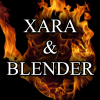My apologies if this is not the right place for this post, I'm not sure exactly where to ask this.
Inspired by some of the Xara/Blender creations posted by James I decided to see if I could manage to learn to use Blender and see if I could create something.
To start I'd like to ask about importing my xara work into Blender, and how to use it once I have it in there. I am sure I will have more questions along the way, already I am finding blender's learning curve much steeper than Xara's.




 Reply With Quote
Reply With Quote





 I love these tools
I love these tools
Bookmarks